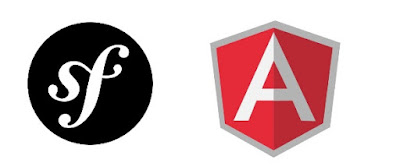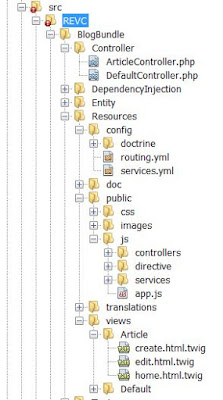This tutorial intends to explain how to integrate Symfony2 routes and angularJs routes in order to understand how they are going to communicate.
Step1: First of all, we need to install a bundle called
FOSJsRoutingBundle that will help us to access to the symfony2 route from javascript.
Actually,it's easy to install this is the GIT repository:
FOSJsRoutingBundle
And this is installation Method :
How to install FOSJsRoutingBundle
Step2: Configure our
symfony2 routes.We need to create our routes to access specific actions or method.
in the file: src/REVC/BlogBundle/Resources/config/routing.yml
rou_dispacher:
path: /dispath/{template}
defaults: { _controller: REVCBlogBundle:Default:dispatch }
options:
expose: true
Because we are using the bundle
FOSJsRoutingBundle, we need to expose our route.To avoid creating routes for each action,I've designed this route to receive a parameter which is the template name.
Step3: Create our controller for the route created.
in the file: src/REVC/BlogBundle/controller/ArticleController.php
public function dispatchAction($template)
{
return $this->render('REVCBundle:'.$template);
}
Having that controller, you will be able to access to any template you want.
Of course, don't forget to create yours template in :src/REVC/BlogBundle/Resources/views/Article
Step4: Finally, we need to create our AngularJs route:
I have created my angular files in : src/REVC/BlogBundle/Resources/public/js/app.js
app.config(['$routeProvider',function($routeProvider){
$routeProvider
.when('/home',{
templateUrl: Routing.generate('rou_dispacher',{template:"Article:home.html.twig"})
})
.when('/',{
templateUrl: Routing.generate('rou_dispacher',{template:"Article:home.html.twig"})
})
.when('/edit',{
templateUrl: Routing.generate('rou_dispacher',{template:"Article:edit.html.twig"})
})
.when('/create',{
templateUrl: Routing.generate('rou_dispacher',{template:"Article:create.html.twig"})
});
}]);
As you can see , I have used the functions called
Routing.generate that allows us to communicate with the symfony2 route.
Basically, the Routing.generate will accept the following parameters:
Routing.generate('route_name',{variable});
Having that configuration, it will be easy to work with
AngularJs and Symfony2.
This is the screen shot about the structure folder of my application.








